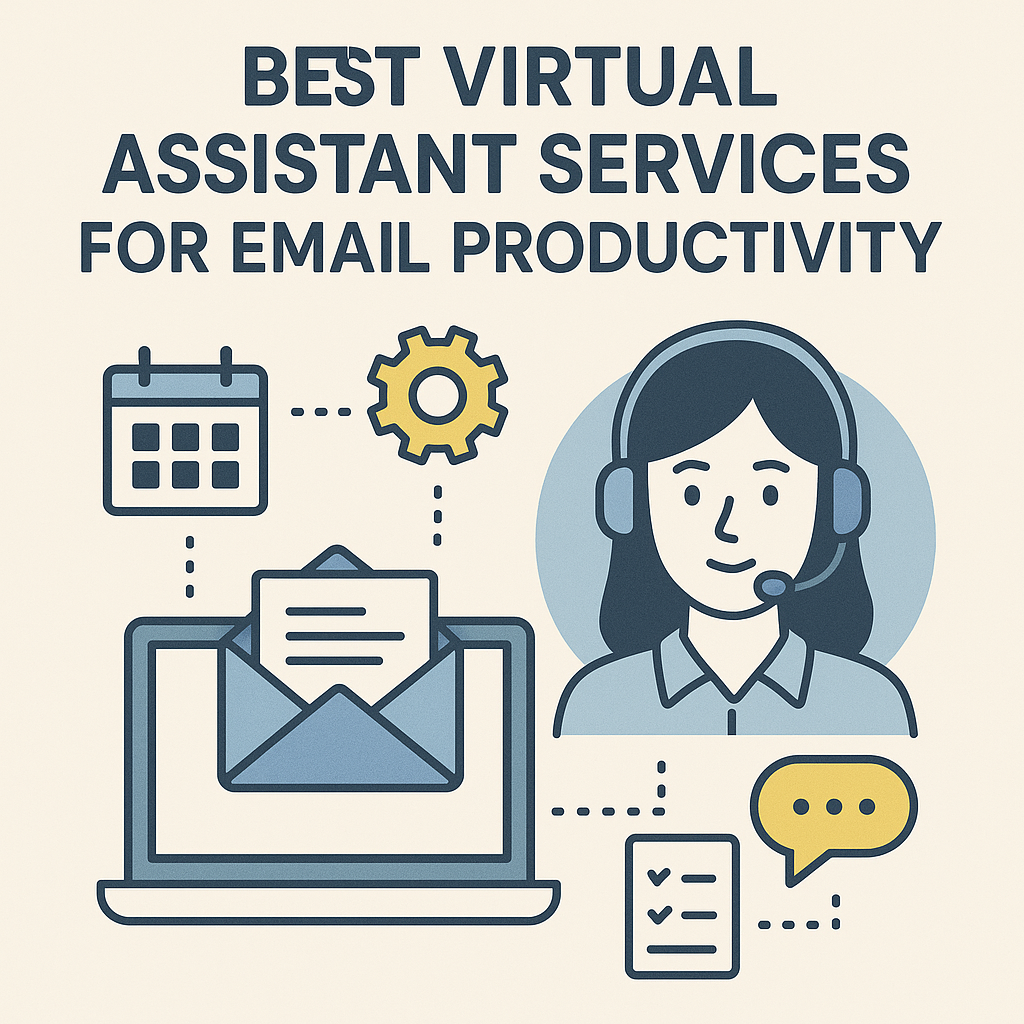Best Virtual Assistant Services for Email Productivity

The relentless ping of incoming messages, the ever-growing unread count, and the gnawing dread of an overflowing inbox – sound familiar? For today's busy professionals, email is more than just a communication channel; it’s often a battlefield. Executives, entrepreneurs, sales teams, and marketing professionals alike find themselves drowning in a sea of digital correspondence. This constant barrage can lead to missed opportunities, delayed responses, decreased productivity, and a significant drain on mental energy. While the concept of virtual assistance has gained immense popularity as a solution, the landscape is rapidly evolving. What if the most effective way to conquer your inbox isn't through human intervention alone, but through the power of artificial intelligence?
What Are Virtual Assistant Services and Why Are They Popular?
In the modern professional world, the demand for efficiency and flexibility has never been higher. This is where virtual assistant services step in, offering a lifeline to overloaded professionals. At its core, a virtual assistant (VA) is a remote professional who provides administrative, technical, or creative assistance to clients. Unlike traditional employees, VAs work independently, often from their own home office, and are typically hired on a contract basis for specific tasks or ongoing support.
The popularity of virtual assistant services has surged due to several key factors:
- Cost-Effectiveness: Hiring a VA is often significantly cheaper than employing a full-time in-house assistant. You avoid costs associated with benefits, office space, equipment, and payroll taxes. You pay only for the hours worked or the tasks completed.
- Flexibility and Scalability: VAs can be hired for a few hours a week or for intensive project-based work. This allows businesses to scale support up or down as needed, adapting to fluctuating workloads without the commitment of hiring permanent staff.
- Access to Specialized Skills: Many VAs possess niche expertise, from social media management and graphic design to bookkeeping and advanced administrative tasks. This means you can find precisely the skill set you need, often at a competitive rate.
- Increased Productivity: By offloading time-consuming tasks, professionals can focus on their core competencies and strategic initiatives, leading to higher overall productivity.
Common tasks that VAs handle include scheduling appointments, managing calendars, making travel arrangements, conducting research, data entry, managing social media accounts, customer support, and, crucially, email management. As the digital economy grows, the need to manage inbox efficiently has become paramount, driving more professionals to seek dedicated support for their email communications. As noted by Forbes Advisor, the market for virtual assistants is robust, with many companies offering specialized services to meet diverse business needs. [^1]
The Limitations of Traditional Virtual Assistants for Email Management
While traditional virtual assistants are invaluable for many tasks, relying solely on human VAs for high-volume email management presents certain limitations. As your business grows and your inbox volume increases, these limitations become more pronounced:
- Scalability Challenges: A human VA, no matter how efficient, has finite working hours and a limited capacity. If your email volume doubles, you might need to hire a second VA, which doubles your costs and adds management overhead. This lack of inherent scalability can be a significant bottleneck.
- Response Time Variability: Even the most dedicated VA needs breaks, sleep, and time to manage multiple clients or tasks. While they strive for promptness, urgent emails might still face delays if the VA is occupied or outside of their working hours. This can impact crucial client interactions or time-sensitive communications.
- Cost Escalation: For professionals who receive hundreds or even thousands of emails daily, managing this influx solely through human VAs can become prohibitively expensive. The hourly rates, even if modest per hour, can add up quickly when multiplied by extensive hours needed for constant inbox monitoring and processing.
- Human Error and Consistency: While VAs are trained professionals, human tasks are subject to occasional errors, fatigue, or variations in approach. Maintaining absolute consistency in tone, response style, and prioritization across a large volume of emails can be challenging.
- Dependency and Training: Building a team of VAs requires ongoing training and management. If a key VA leaves, there's a period of knowledge transfer and retraining, potentially disrupting workflow.
These factors highlight that while human VAs are excellent for complex, nuanced, or relationship-driven communication tasks, they may not be the most efficient or cost-effective solution for the sheer volume and routine nature of much of modern email management. This is where a new breed of assistant is emerging.
Introducing AI-Powered Email Assistants: The Future of Inbox Productivity
The digital revolution is not just about outsourcing tasks; it's about leveraging technology to achieve unprecedented levels of efficiency. Artificial intelligence (AI) is at the forefront of this transformation, and its application in email management is nothing short of revolutionary. We are moving beyond simple automation to intelligent, proactive assistance. This is the domain of AI-powered email assistants.
An AI email assistant is a sophisticated software solution that utilizes advanced technologies like Natural Language Processing (NLP), Machine Learning (ML), and predictive analytics to understand, sort, prioritize, and even respond to emails autonomously. Unlike a human VA who needs explicit instructions for every action, an AI assistant can learn from patterns, context, and your preferences to manage your inbox intelligently.
The benefits of adopting AI for email management are compelling:
- Unmatched Scalability: AI assistants can handle virtually unlimited volumes of email without a dip in performance. Whether you receive 50 emails a day or 5,000, the AI scales instantly.
- 24/7 Availability: AI works around the clock, ensuring your inbox is managed and critical communications are handled regardless of time zones or your working hours.
- Blazing Speed: AI can process, categorize, and respond to emails at speeds far exceeding human capabilities, drastically reducing response times.
- Cost-Effectiveness at Scale: While there's an initial investment or subscription fee, the cost per email processed by an AI assistant is typically far lower than that of a human VA, especially at high volumes.
- Learning and Improvement: AI systems continuously learn from your interactions, becoming more adept at understanding your priorities, communication style, and preferred responses over time.
For professionals struggling with inbox overload, consider leveraging an ai executive assistant to revolutionize how you handle your daily influx of messages. These advanced tools are designed to understand context, prioritize urgency, and even draft responses, freeing up significant cognitive load. They represent a paradigm shift, moving email management from a laborious chore to a streamlined, intelligent process. This evolution aligns with the broader trend of adopting AI productivity tools to enhance work efficiency.
How AI Assistants Automate Email Tasks: Examples and Benefits
AI-powered email assistants are not just theoretical concepts; they perform concrete, valuable tasks that directly impact your productivity. Here are some key ways they automate email management, along with the significant benefits they offer:
Key Automation Capabilities:
- Intelligent Sorting and Prioritization: AI can scan incoming emails and categorize them based on sender, keywords, sentiment, and historical interaction data. It can automatically flag urgent messages, filter out spam and newsletters, and route emails to appropriate folders or team members. This ensures you see what matters most, first.
- Automated Response Drafting: For common inquiries or routine confirmations, AI can generate contextually relevant draft responses. These can range from simple acknowledgments to detailed answers based on pre-defined templates or learned patterns. Your role then becomes reviewing and sending, rather than composing from scratch.
- Smart Scheduling and Calendar Management: AI assistants can analyze email content to identify meeting requests, suggest optimal times based on your calendar availability and preferences, and even send out calendar invites automatically. This significantly reduces the back-and-forth often associated with scheduling.
- Proactive Follow-ups: AI can track emails that require a response or follow-up and automatically send reminders to you or even draft follow-up messages to the original sender if no action has been taken within a specified timeframe.
- Unsubscribe Management: Overwhelmed by promotional emails? AI tools can identify mailing lists you're subscribed to and help you unsubscribe efficiently, decluttering your inbox over time.
- Email Summarization: For long email threads or complex messages, AI can provide concise summaries, allowing you to grasp the core information quickly without reading every word. This is a powerful feature for catching up after being away.
- Sentiment Analysis: Some advanced AI assistants can gauge the sentiment of an email (positive, negative, neutral), helping you prioritize responses to potentially unhappy clients or urgent customer service issues.
Tangible Benefits:
- Drastic Reduction in Response Times: By automating initial responses and flagging urgent matters, AI ensures that critical communications are addressed much faster, improving client satisfaction and operational agility.
- Enhanced Accuracy and Consistency: AI performs repetitive tasks with a high degree of accuracy and consistency, eliminating human error and ensuring a uniform communication standard.
- Significant Time Savings: By taking over the manual, time-consuming aspects of email management, AI frees up hours each week, allowing professionals to focus on strategic, high-value activities.
- Improved Focus and Reduced Cognitive Load: An AI assistant acts as a filter and organizer, reducing the mental effort required to sift through and manage a chaotic inbox. This leads to better concentration on important tasks.
- Cost Efficiency at Scale: For businesses with high email volumes, the operational cost of AI management is far lower per email than hiring additional human support, making it a highly scalable and cost-effective solution.
These capabilities demonstrate how AI assistants are fundamentally changing the way we handle digital communication, making it possible to manage inbox efficiently and effectively, even under heavy load. This directly supports goals like achieving an inbox zero strategy more consistently.
Choosing the Right Email Assistant: AI vs. Human VA
The decision between an AI email assistant and a traditional human virtual assistant isn't always an either/or scenario. In fact, the most effective email management strategies often involve a synergy between the two. However, understanding their distinct strengths and weaknesses is crucial for making the right choice for your specific needs:
| Feature | Traditional Human VA | AI Email Assistant |
|---|---|---|
| Scalability | Limited. Requires hiring more people for increased volume, which increases costs and management complexity. | Virtually unlimited. Handles massive volumes seamlessly. |
| Cost | Hourly or retainer fees. Can become expensive for high-volume, 24/7 management. | Subscription-based. Often more cost-effective per-email at scale. |
| Speed | Subject to human working hours and task load. Can have delays. | Near-instantaneous processing and response capabilities. Operates 24/7. |
| Task Complexity & Nuance | Excels at complex, nuanced conversations, relationship building, and tasks requiring high emotional intelligence or creative problem-solving. | Best for structured, repetitive tasks; improving rapidly in understanding nuance but may struggle with highly complex or sensitive situations without human oversight. |
| Consistency | Can vary due to human factors (fatigue, mood, interpretation). | Highly consistent, adhering strictly to programmed logic and learned patterns. |
| Learning & Adaptability | Learns through experience, direct feedback, and coaching. Can adapt creatively. | Learns through data, algorithms, and user feedback. Adapts based on patterns. |
| Best Use Case for Email | Handling high-touch client communications, complex negotiations, sensitive customer service issues, personalizing outreach, and managing exceptions. | Filtering, sorting, prioritizing, responding to routine inquiries, scheduling, follow-ups, and managing high volumes of informational emails. |
The Hybrid Approach: The Best of Both Worlds
For many professionals, the optimal strategy for email management solutions involves a hybrid model. An AI assistant can act as the first line of defense, handling the bulk of incoming emails: sorting, prioritizing, answering frequently asked questions, and scheduling meetings. This frees up the human VA (or the professional themselves) to focus on the emails that require a human touch – complex inquiries, sensitive client interactions, strategic communications, and exceptions that the AI may not be equipped to handle. This approach ensures efficiency, scalability, and maintains the crucial element of human connection where it matters most. Effectively, you leverage AI to manage inbox efficiently, and use human VAs to master the art of high-value communication.
Exploring this synergy is key to mastering email inbox management.
Boosting Productivity with AI Email Management: Actionable Tips
Integrating AI into your email workflow can be a game-changer, but it requires a strategic approach. Here are actionable tips to help you harness the power of AI email assistants and maximize your productivity:
- Define Your Email Management Goals: Before diving in, clarify what you want to achieve. Is it reaching an inbox zero strategy consistently? Reducing your average response time to under an hour? Spending less than 30 minutes daily on email triage? Clear goals will guide your tool selection and implementation.
- Identify Repetitive Tasks and Patterns: Analyze your inbox for common email types, recurring questions, and routine actions. These are prime candidates for AI automation. For example, if you frequently schedule meetings, an AI assistant that handles scheduling can save you significant time.
- Start with a Pilot Program: Don't try to automate everything at once. Select one or two AI tools or specific features (like intelligent sorting or response drafting) and test them on a subset of your inbox or for a specific type of email. This allows you to learn how the tool works and assess its effectiveness without disrupting your entire workflow.
- Choose the Right AI Tools for Your Needs: Research different AI productivity tools available. Some are standalone email clients, while others integrate with existing platforms like Gmail or Outlook. Consider features like integration capabilities, learning capacity, security, and pricing models. Explore tools that can help you automate email tasks effectively.
- Integrate Seamlessly with Your Existing Workflow: Ensure your chosen AI assistant can sync with your calendar, CRM, project management tools, and other essential software. This creates a cohesive ecosystem where information flows smoothly, enhancing overall efficiency. For instance, using an AI tool that integrates with your calendar can streamline the process of responding to meeting requests.
- Train Your AI Assistant Diligently: Most AI tools learn from your interactions. Be consistent in how you categorize emails, respond to AI-suggested drafts, and manage your inbox. The more data and feedback you provide, the better the AI will become at understanding your preferences and priorities. Think of it as onboarding a new team member.
- Leverage AI for Drafting and Summarization: Use AI to help draft common replies or summarize lengthy threads. This significantly cuts down on the time spent composing emails. Always review and personalize AI-generated drafts to maintain your unique voice and ensure accuracy. This is a core aspect of mastering work email productivity.
- Focus Your Human Effort on High-Value Communication: By letting AI handle the routine and high-volume tasks, you free up your valuable time and mental energy. Direct this focus towards complex problem-solving, strategic planning, building client relationships, and crafting personalized, impactful messages.
- Regularly Review and Refine Settings: AI is not a "set it and forget it" solution. Periodically review your AI assistant's performance. Are the categorizations accurate? Are the response suggestions helpful? Adjust settings, retrain the AI if necessary, and adapt your strategy based on the results. This ensures continuous improvement in your email productivity tools.
- Explore Advanced Features for Deeper Efficiency: As you become more comfortable, explore more advanced AI capabilities such as sentiment analysis to prioritize customer feedback, or predictive text for faster typing. Tools designed to help you manage inbox efficiently often have layers of functionality waiting to be unlocked.
By following these tips, you can effectively leverage AI to transform your email management from a source of stress into a powerful productivity driver, helping you achieve a cleaner inbox and more focused workdays. For those looking to enhance their overall digital workflow, exploring AI productivity tools is a critical step.
Conclusion: Reclaim Your Time with Smart AI Email Solutions
The modern professional landscape is defined by the constant demand for speed, efficiency, and effective communication. Yet, for many, the inbox remains a significant bottleneck, consuming valuable time and mental energy that could be better spent on strategic initiatives. While traditional virtual assistant services offer a welcome respite from email overload, the advent of AI-powered email assistants represents the next frontier in productivity.
These intelligent tools offer unparalleled scalability, 24/7 availability, and remarkable speed in sorting, prioritizing, and responding to emails. By automating repetitive tasks and providing intelligent insights, AI assistants empower professionals to manage their inboxes more efficiently than ever before. They are not merely tools for task completion; they are strategic assets that help reclaim precious work hours, reduce cognitive load, and ensure that critical communications are never missed.
Whether you're an executive drowning in correspondence, an entrepreneur juggling multiple roles, or a sales and marketing professional managing client outreach, embracing AI for email management is no longer a luxury—it's a necessity for staying competitive and productive. By strategically integrating AI into your workflow, you can move beyond simply managing your email to mastering it, transforming a source of stress into a catalyst for success.
Don't let your inbox dictate your day. Explore the capabilities of AI email assistants and discover how they can help you achieve your inbox zero strategy, boost your overall productivity, and ultimately, reclaim your most valuable asset: your time. The future of email management is here, and it's smarter, faster, and more efficient than ever.
[^1]: Forbes Advisor. (2025). 9 Best Virtual Assistant Services Of 2025. Retrieved from [https://www.forbes.com/advisor/business/software/best-virtual-assistant-services/](https://www.forbes.com/advisor/business/software/best-virtual-assistant-services/) ```


